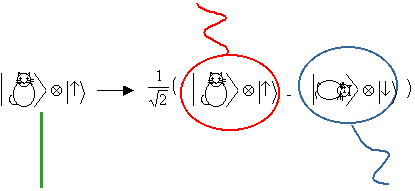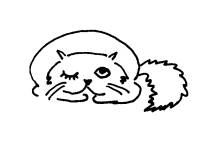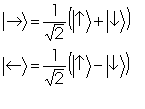




Formally, the cat paradox can be expressed by the following schematic equation (for simplicity, we replace the radioactive substance by a single atom that can be found excited: '↑' or decayed: '↓' :
Eq. (1) represents the temporal evolution of the compound system cat + atom. Along with time, the probability of finding the atom decayed increases, and the cat-atom quantum state evolves into an entangled state (right-hand side of eq. (1)). At this stage, the atom and the cat are strongly correlated. For example, if the atom is found to be excited, we know for sure that, if we look at the cat, we will find it 'living'. Similarly, if the atom is found to be decayed, the probability to find the cat 'dead' is 1. These perfect correlations have nothing particularly extravagant. But they are only a small subset of the correlations entailed by state (1). We have been considering so far only one observable of the atom, namely its internal energy E, whose eigenvectors are ![]() and
and ![]() .
.
Let's consider now a different observable, Q, whose eigenvectors are the states:

Observable Q can be given a pictorial meaning by referring to classical electromagnetism, but, for our purposes, it is sufficient to identify Q's possible outcomes, ' ←' and '→', with the mutually exclusive results of an experimental protocol that can consistently be called 'a measurement of Q'. (A helpful analogy is provided by spin observables: the relation existing between E and Q, as well as the relation existing between their respective eigenvectors, is similar to that existing between Sz and Sx, and between their respective eigenvectors.) Now suppose we want to rewrite state (1) in terms of the eigenvectors of Q. In analogy with the case of two entangled spins, a formal calculation leads to the following expression:
Having carried out these formal developments, we are now in a position to look at the consequences of Schrödinger's paradox. For, what happens to the cat if we measure Q on the atom and find for example '→'? It follows from eq. (2) and from the properties of entangled states that, in this case, the results of any further measurement carried out on the cat alone are those predicted by the following state vector:
Does this quantum state imply the existence of a cat which is simultaneously dead and alive? Not at all. If the biological status of the cat is checked, according to state (3) the cat is simply found alive half of the times and dead the other half. However, state (3) also predicts interference effects if the appropriate observable is measured. If these interference effects were usually observed, as they are for atoms (see wave-particle duality), our very conception of cats would turn out to be quite inadequate to fit our own experience. As inadequate, in fact, as classical models of particles are to fit microscopic experience (see uncertainty and wave-particle duality).